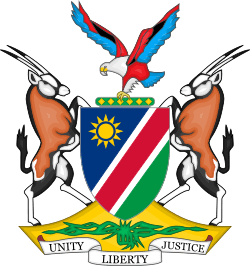Government of Namibia
The Government of Namibia consists of the executive, the legislative and the judiciary branches. The Cabinet is the executive organ of government, implementing the laws of the country. It consists of the President, the Prime Minister and his deputy, as well as the Ministers. The legislative organs of government are the National Council and the National Assembly. They make the laws of the country. The judiciary organs of government are the courts. The highest court of Namibia is the Supreme Court. There is also the High Court, and lower courts.[1]
 |
|---|
| This article is part of a series on the politics and government of Namibia |
|
|
|
The Namibian government is partly centralised and partly regional. In the executive branch, Central government consists of ministries, offices and agencies, whereas regional government consists of Regional Councils, and constituencies within these.[1] The legislation is centralised in the lower house (National Assembly), and regional in the upper house (National Council).[2] The judiciary is centralised in the Supreme Court, whereas High Courts and lower courts are distributed all over the country.
Executive branch of government
The central executive branch of government consists of Offices, Ministries, and Agencies. The Offices of central government are:[3]
- Office of the President (OoP)
- Office of the Prime Minister (OPM)
- Office of the Judiciary (OoJ)
As of 2020 there are 23 Ministries in Namibia:[3]
- Ministry of Agriculture, Water and Forestry (MAWF)
- Ministry of Defence (MoD)
- Ministry of Education, Arts and Culture (MoE)
- Ministry of Environment and Tourism (MET)
- Ministry of Finance (MoF)
- Ministry of Fisheries and Marine Resources (MFMR)
- Ministry of Gender Equality and Child Welfare (MGECF)
- Ministry of Health and Social Services (MHSS)
- Higher Education, Training and Innovation (MHETI)
- Ministry of Home Affairs and Immigration (MHA)
- Industrialization, Trade and SME Development (MTI)
- International Relations and Cooperation (MIRCo)
- Ministry of Information and Communication Technology (MICT)
- Ministry of Justice (MoJ)
- Labour, Industrial Relations and Employment Creation (MOL)
- Ministry of Land Reform (MLR)
- Ministry of Mines and Energy (MME)
- Poverty Eradication and Social Welfare (MPESW)
- Ministry of Public Enterprises (MSS)
- Ministry of Safety and Security (MSS)
- Sport, Youth and National Service (MSYNS)
- Ministry of Works and Transport (MoW)
- Urban and Rural Development (MURD)
The Agencies of central government are:[3]
- Anti-Corruption Commission (ACC)
- Electoral Commission (EC)
- Central Intelligence Service (NCIS)
- National Planning Commission (NPC)
- Office of the Attorney-General (OAG)
- Office of the Auditor-General (OAG)
- Office of the Ombudsman
- Public Service Commission of Namibia (PSC)
Government organisations and state-owned enterprises
The Namibian state runs and owns a number of companies such as Air Namibia, Transnamib and NamPost, most of which need frequent financial assistance to stay afloat.[4][5]
There is a number of agencies and authorities established by Acts of Parliament that can be considered government organisations:
- Namibia Tourism Board (NTB), the regulatory and marketing body for tourism activities in Namibia, and is headquartered in Windhoek, Namibia.[6][7]
- Namibia Qualifications Authority (NQA). This institution evaluates and accredits national institutions and degrees, as well as foreign qualifications of people who wish to demonstrate the national equivalence of their degrees earned abroad.[8]
- Law Reform and Development Commission (LRDC) commission responsible for research recommended law changes to the Ministry of Justice.
External links
- Government of Namibia, www.gov.na
References
- "About the Government of the Republic of Namibia". Office of the Prime Minister. Archived from the original on 30 November 2012. Retrieved 29 September 2011.
- "GRN Structure. The Legislature". Government of Namibia. Archived from the original on 18 August 2011. Retrieved 29 September 2011.
- "Government of Namibia". Office of the Prime Minister. Retrieved 2 February 2020.
- "Government income from SOEs 2013/2014-2015-2016". Insight Namibia. April 2013. p. 21.
- "Payments and transfers to SOEs 2013/2014-2015-2016". Insight Namibia. April 2013. p. 22.
- "Namibia Tourism Board | Namibia Information". businessdirectory.na. Archived from the original on 2014-04-01. Retrieved 2015-12-07.
- "Namibia Tourism Board". www.namibia-1on1.com. Retrieved 2015-12-07.
- "NQA:: History". Namibia Qualifications Authority. Archived from the original on 24 August 2012. Retrieved 1 November 2012.